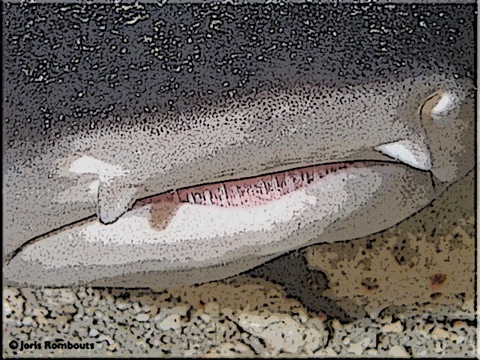
- Check the sub-map for the specimen information files -
SHARKS
From the moment the word "shark" has been said, many people change face because of fear. For most people sharks are nothing else than vicious killing man-eaters. All this negative publicity, fear and targeted fishing during the years, helped them on their way to extinction. As long we are not able to change peoples thoughts about this cruel business, poachers will continue with their barbaric acts. More and more people start to investigate the behavior of sharks by spending more time with them underwater. Because of all this research we now know that only a few species of sharks can be genuinely dangerous in certain circumstances, but none can be considered well-known. We have to let the people know about the sharks their importance in the ecosystem and protect these beautiful and useful animals.
Sharks belong to the oldest vertebrates swimming all seas and oceans. The oldest known fossil members ever existed of this group are more than four hundred million years old. They are well developed to live a life in their oceans. There are three hundred fifty known species, and maybe more. Sharks have a comparatively large brain and an impressive set of sensory organs which they use for navigating and to track prey. They have a lateral line system on both sides of the body which is concentrated around the head going to the tail fin. This lateral line system is a row of small pores with which they can detect vibrations caused by wounded fish and localize electric fields from quite a distance. Sharks also have a great smell for oily fish blood and a good eyesight on short distances. As most predators, their body is well designed too move fast. Shark-skin is covered with small dermal denticles(small teeth) instead of the bony scales of teleosts (bony fishes). Their teeth are embedded in the gums and continuously replaced. This explains why shark teeth are often found on the sea floor, especially during dredging activities. Sharks their teeth mostly show what their diet is, small fish , big fish, crustaceans, all of them are scavengers and are not really picky. Most sharks have to keep on swimming so more water runs true the gills to oxygenate the body. Some species like the nurse- and white-tip reef shark are able to pump in water, thats why we most of the time see them laying down on the bottom, in caves or underneath rocks or coral tables repeatedly opening their mouth. For many sharks mating season is the only time they come in contact with members of their own genus. For many sharks this is the start of a migrating period. Mating takes place on or close to the bottom and happens in a belly to belly position. The males try to keep the females into position by biting them in the pectoral fins, tail fin, belly or back. These females end up with serious bite marks, this probably explains why the females have a much thicker skin than the males. Some shark species lay egg capsules (Oviparous) which they attach to plants, rocks or other things which are available at the time. The egg capsules hatch after two months to over a year depending the species. With all other species, the young grow up in the safety of their mothers "womb" (Ovoviviparous).
- Check the sub-map for the specimen information files -






